Seoul-tripping
I'll start with a trip that Char and I took in February, merely a few days after my return from Down Under. We decided we hadn't seen Seoul properly - it is, after all, this wonderful nation's capital, we needed to give it some attention.
So we headed up to Seoul on the KTX - Korea's super-fast train. It cuts the travel time nearly in half, and even though for part of it we were travelling at around 190 mph, it certainly didn't feel like it.
We had planned the weekend as a cultural, sight-seeing trip, as in, no alcohol involved. I made the mistake, however, of taking Char to an Irish pub, the Wolfhound, where we had a couple of Baby Guinnesses, and she decided we had to go dancing. After a quick look at the world's least lively salsa club, we found a standard club, and hit the dancefloor. The night unfolded from there, and we ended up at 4am in a food tent, eating mussels (which I hate, but felt like I had to eat because it was service) and what we can only assume was rat. We made it home around 7am, which affected somewhat the plans that we had made to start our sightseeing early!
But if you know me, you know I don't sleep late, and you know when I'm going sightseeing, I'm irritatingly awake and perky early. After pestering Char (who likes her sleep - sorry Char!) for hours, we finally got going around 1pm.
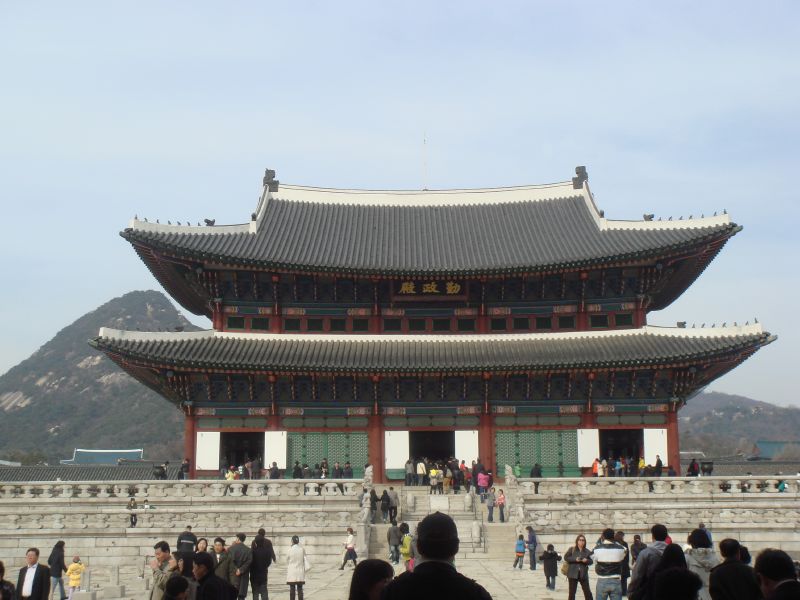
Our first stop was Gyeongbokgung, which was a principal palace up until the 16th century. As with most palaces in Korea, it was burned down during a Japanese invasion, and lay in ruins until the 19th century when restoration started. But, once again, the Japanese stepped in* and during Korea's occupation by imperialist Japan, most of the 330 buildings were destroyed. Since the liberation of Korea, restoration has continued, and work still goes on.
Palace sites here are all basically similar: main halls and pavilions, courtyards, residential quarters. My favourite part of Gyeongbokgung was the island pavilion, a hall set in the middle of a lily pond.
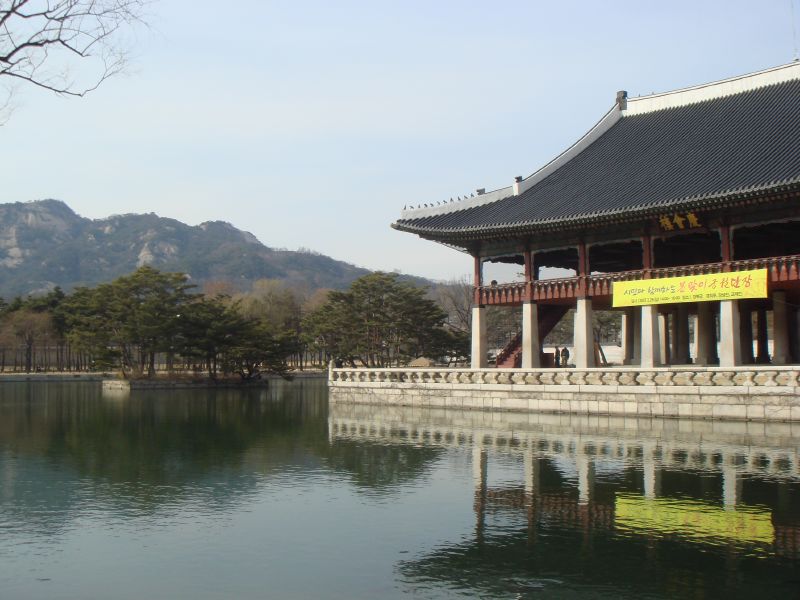
It's always a history lesson visiting places like this (although the history of wooden buildings often reads: "Burned down in 1348; rebuilt, struck by lightning and burned down in 1510; destroyed during an invasion, 1578; struck by lightning and destroyed in 1650" and so on...!) At this palace, they also have a ceremony that
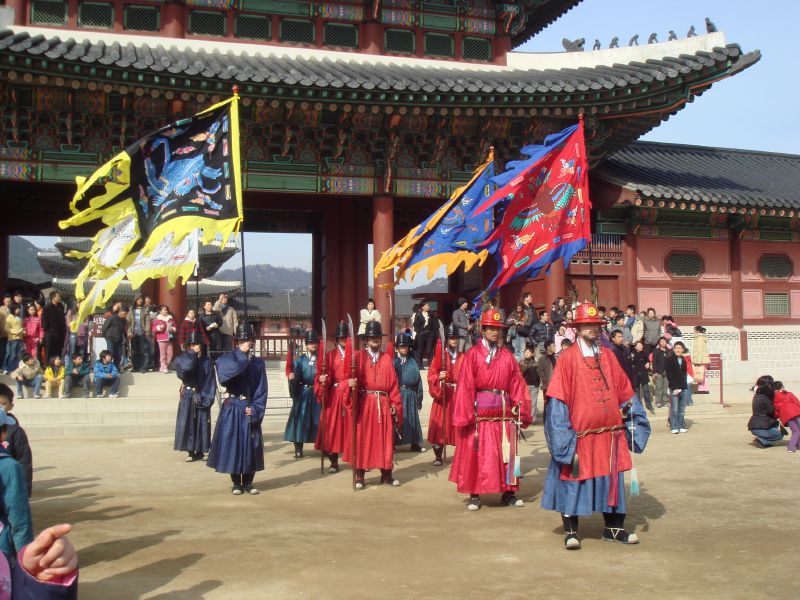 folks back home would be familiar with: a changing of the guard. I've never seen the changing of the guard in London, but the one at Gyeongbokgung was interesting: the fresh soldiers marched up and down a few times in front of the entrance, with their flags and their drums, and then turned to face the guards on their way out. The leader of each exposed a large medallion to the other leader, on which was a symbol - we assume this was to prevent imposters, as the symbols had to match.
folks back home would be familiar with: a changing of the guard. I've never seen the changing of the guard in London, but the one at Gyeongbokgung was interesting: the fresh soldiers marched up and down a few times in front of the entrance, with their flags and their drums, and then turned to face the guards on their way out. The leader of each exposed a large medallion to the other leader, on which was a symbol - we assume this was to prevent imposters, as the symbols had to match. 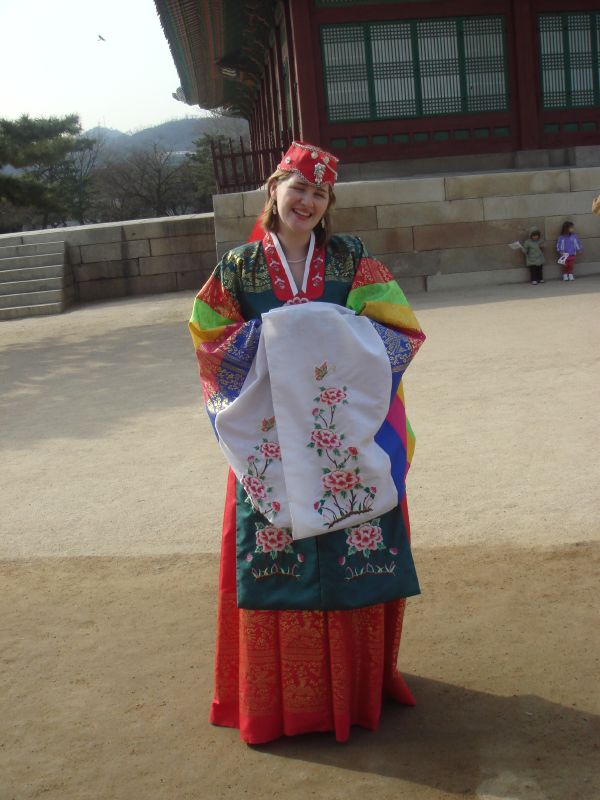 While we were in the palace, Char and I were suckered into paying a few quid to be dressed up in traditional Korean wedding clothes (hanbok) and have our photos taken! It was fun though. We were parading through the grounds like royalty!
While we were in the palace, Char and I were suckered into paying a few quid to be dressed up in traditional Korean wedding clothes (hanbok) and have our photos taken! It was fun though. We were parading through the grounds like royalty!From the palace, we went to find dinner, and headed on a long walk in the direction of something that I had read about and wanted to see. A Statue of a Hammering Man....that moves!
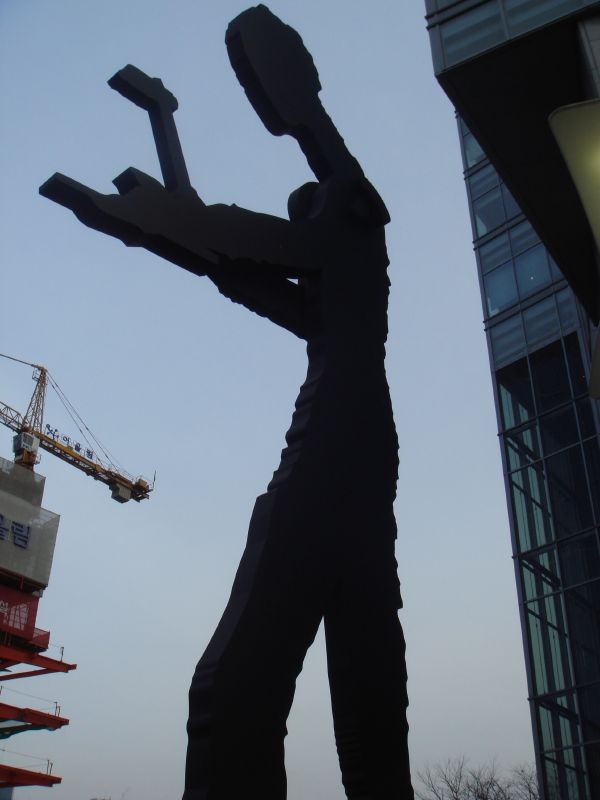 I don't think Char was suitably impressed, but, wow! It was very tall indeed, but only a few inches thick, and the hand with the hammer slowly moved up and down. Very relaxing. I could have looked at it for days, but had to give in to Char.
I don't think Char was suitably impressed, but, wow! It was very tall indeed, but only a few inches thick, and the hand with the hammer slowly moved up and down. Very relaxing. I could have looked at it for days, but had to give in to Char.Our next destination was Insadong, an area famous for arts and crafts, and tea. There are lots of Korean souviner shops, and many delightful pieces of Korean art to look at: ceramics, paintings, sculptures. There are also art galleries and many tea shops. We had a gander for a little while, but were feeling quite tired, so decided to head back to the hotel for a nap before heading out for dinner. At 11pm, we woke up and ordered pizza!
The next morning, we once again struggled with getting up, but finally made our way to Namdaemun market, which is one of the biggest wholesale markets in Seoul, selling all sorts of goodies. We didn't do too much shopping, as we were both just back from pricey winter vacations, but it was interesting to see. At one point, we engaged in conversation with a male seller who was dressed in women's clothes, and we became the talk of the street for a while as he was still "talking" to us when we were halfway down the street!
From the market, we headed south of the river to the monstrous COEX complex. There's a mall, food courts, department stores, cinemas, games places, and - what we were going to - an aqquarium. I love aquariums. Except for the Japanese spider crabs that I'm terrified of (saw them first in Osaka...evil looking things). This one was quite good: it had a tank full of sharks (that Char provided a soundtrack to. No prizes for guessing what song), lots of pretty little fish and enough ugly fish to make fun of, and - this is the best part - a two-headed turtle! I kid you not.
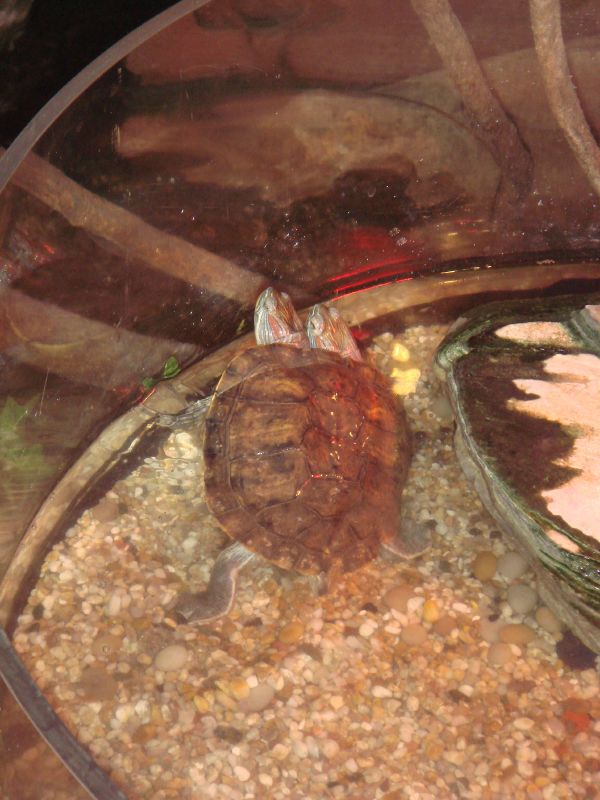
From the aquarium, we headed back to the Irish pub that had started the trouble on Friday night. We were returning for dinner, as Char had discovered that they served Toad in the Hole, and I had been before and knew how good the food was (best chips this side of London). We were also meeting Katy, who is a friend of a university friend of mine, and had just moved to Korea less than a month earlier. (Incidentally, this was the day after we beat the English in the rugby, and I managed to catch the last 10 minutes of the replay in the pub!)
It was a nice relaxed evening, some good homely grub, and good conversation with new people. But Char and I were having a (relatively) early night in preparation for our adventures the next day: we were headed to the DMZ.
The last Cold War border
The DMZ is the Demilitarised Zone, the area that stretches the length of the North-South border and extends 2km on either side. The phrase "demilitarised zone" is a bit of a misnomer, as it is actually the most heavily fortified border in the world. And it is the last remaining Cold War border: in most of the rest of the world, the Cold War and the communist/capitalist struggle is but a distant memory. Americans and South Koreans cannot visit, and other visitors have to go in a group, so Char and I, and a few other English-speakers were tagged onto a Japanese tour group.
As you might know, North Korea is my particular area of study, and the motivation for me coming out here. At some point before I leave, I hope to make it to North Korea proper, but this is also something I wanted to do.
The closer you get to the edge of the DMZ, the more visible the security fears: watchtowers, anti-tank barriers, barbed wire, a distinct lack of housing or development. The first stop in the DMZ itself is Camp Bonifas, and from here it is only a stone's throw to the JSA - Joint Security Area - which is occupied by Korean People's Army soldiers to the North, and to the South, by a UN Command made up of South Korean and US soldiers. The UNC's motto is "In front of them all".
While being taken to the first checkpoint (one of four) we were instructed not to take photos, not to point, and not to gesture towards the NK soldiers. These last two instructions remained in place throughout all out time in the DMZ, but we were allowed to take photos at certain points.
At the first checkpoint - Checkpoint Alpha, the entrance to Camp Bonifas - we were taken off the bus to a briefing room, where we were given a short history of the area, a rundown of the rules, a guest badge, and a declaration to sign. The declaration contained rules such as:
1. The visit to the Joint Security Area at Panmunjeom will entail entry into a hostile area and possibility of injury or death as a direct result of enemy action...Although incidents are not anticipated, the United Nations Command, the United States of America, and the Republic of Korea cannot guarantee the safety of visitors and may not be held accountable in the event of a hostile enemy act...
2.c) Fraternisation, including speaking or any association with personnel from the Korean People's Army/Chinese People's Volunteers (KPA/CPV) side, is strictly prohibited. [Military] personnel...are identified as follows: brown or olive drab North Korean uniforms...
2.d) Visitors will not point, make gestures, or expressions which could be used by the North Korean side as propaganda material against the United Nations Command...
2.i) If any incidents should occur, remain calm, and follow instructions issued by security personnel.
It was the last one that I particularly liked, its matter-of-factness.
After the briefing - and some of you will appreciate this bit - we had a group photo taken, with a banner saying where we were, and this photo was available for us to purchase later, in a book that explained everything that we would see. Most of us opted not to buy, partly because of the price-tag, and partly because we were already mildly uncomfortable at how such a flashpoint has been made a tourist attraction.
We changed buses for the journey into the JSA, but we were all to stick to our assigned seat numbers, for security and to keep us in line, I guess; our passports were checked maybe three times throughout the whole trip.
The short drive into the JSA was quite eerie; the DMZ is largely unoccupied, except for one village on either side. The South Korean village, Daesong, is famous for rice and ginseng, and the 200-odd residents all must have been resident there before the Korean War or had family who were. They have an 11pm curfew and soldiers stand guard around the clock. One might wonder who in their right mind would choose to live in a place that is so close to the most potentially dangerous border in the world. They pay no taxes, and are the richest farmers in all of Korea.
During the drive, we passed under a number of odd looking bridges, and were informed that they were in fact anti-tank mechanisms: were there to be an invasion, these "bridges" would be blown up, and the rubble would block the road, halting the progress of tanks and troops. We were told that much of the land we were passing by is littered with land mines; but it is also an incredibly ecologically diverse area, because it has been left practically untouched for over 50 years.
We were told a bit about the North Korean military force, some information that I was already aware of: it is the 5th largest military in the world, and is the most militarised nation in proportion to population, and every NK male has to perform ten years of military service.
(I should point out that as we were going, I was discreetly taking notes.)
A short time later, we arrived at Panmunjeom, the village at the JSA. Here, on the South side, are two buildings: Freedom House and Peace House. This is where defectors are received. We were taken firstly through to the blue UN buildings that straddle the border, where negotiations still sometimes take place. And this is about as close to North Korea as most people usually get.
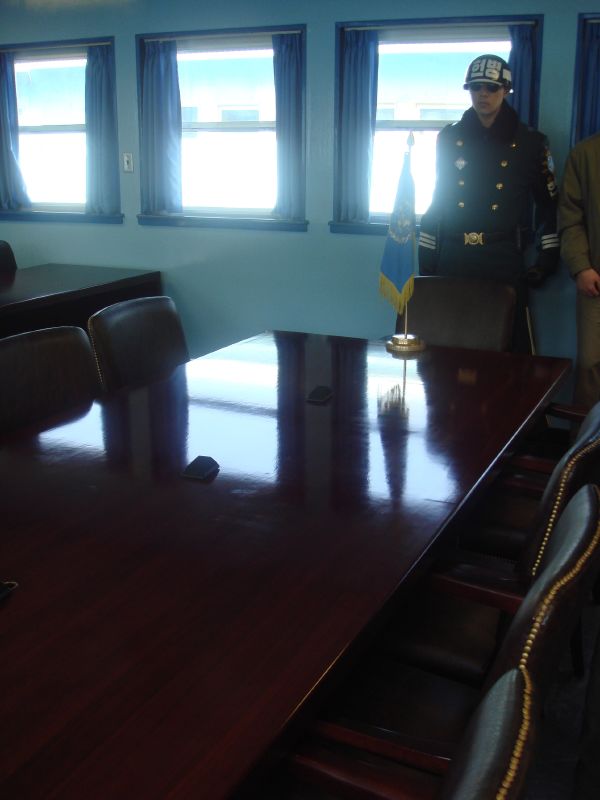
Inside the main building is a few desks and chairs: one side is South Korean, the other, North Korean. Only one side is allowed to have a tour group in at any one time, thus preventing any communication between the two sides. And while there are SK visitors, the SK soldiers stand guard, and vice versa. A soldier stands guard over the door that leads into North Korea, and I couldn't help but imagine this as a Lion, The Witch and the Wardrobe style situation: a doorway that leads to a (for me, in a sense) magical, curious and unknown world.
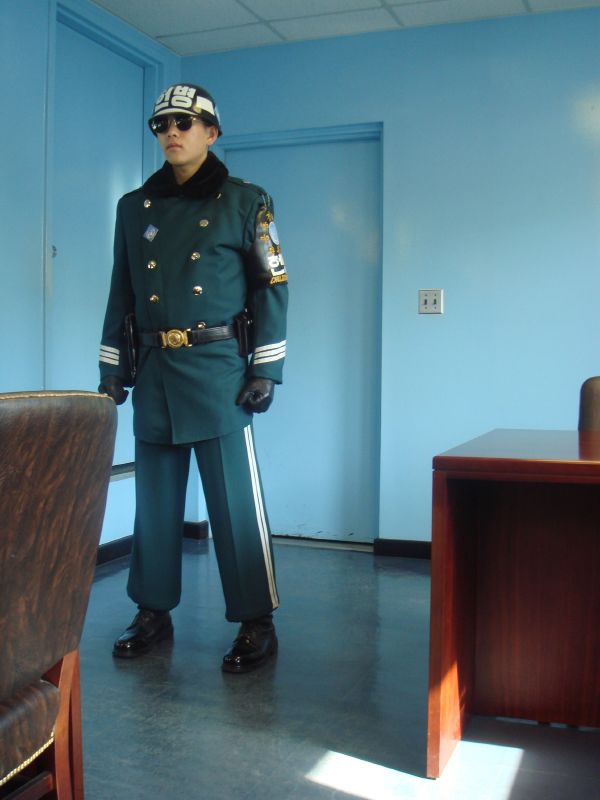
We obviously weren't allowed to speak to the soldiers, but we were permitted to take photos with them. Many people did, and Char had one taken also, but I never feel entirely comfortable having my photo taken with soldiers on duty, and this situation left me feeling even more uncomfortable.
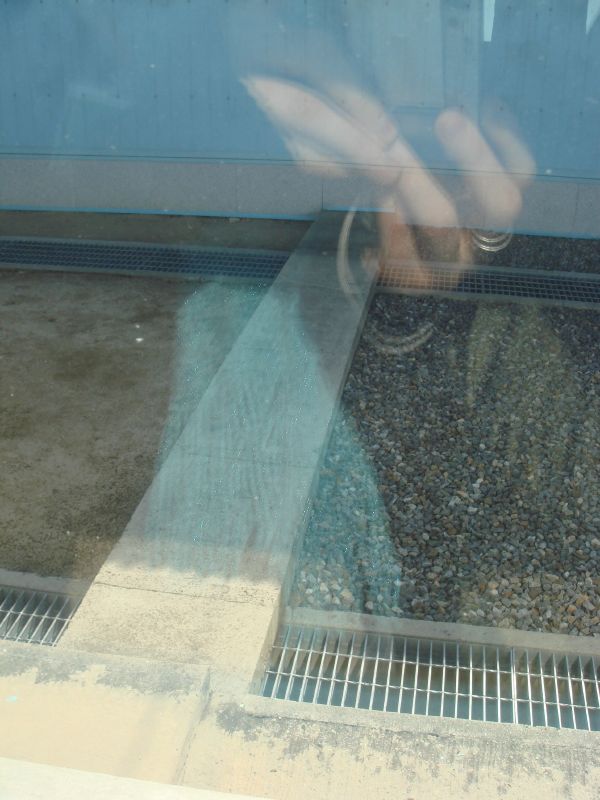 While in the room, we were able to walk in and out of the North Korean side, but I do hope to make it into NK proper later this year. We could see the concrete ridge outside that marks the border itself - you're never allowed to forget even for a second where the line is.
While in the room, we were able to walk in and out of the North Korean side, but I do hope to make it into NK proper later this year. We could see the concrete ridge outside that marks the border itself - you're never allowed to forget even for a second where the line is.The soldiers on guard in the hut and outside all stand in a rather peculiar taekwondo stance, so that they are standing in readiness: they are leaning forward slightly, and their fists are clenched by their side. They also wear dark sunglasses, probably as an intimidation technique.
After leaving the UN hut, we were led to a pagoda that sits next to Freedom House,
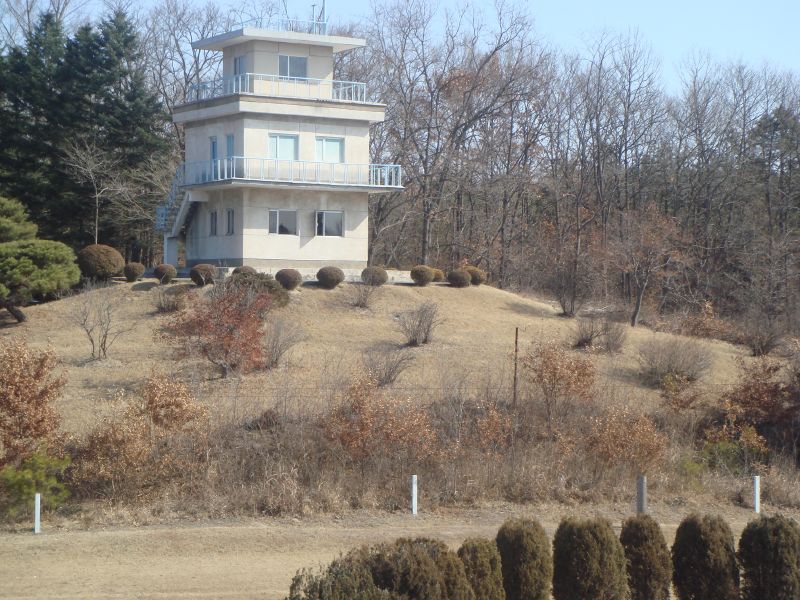 and from here we could see into the North Korean side. NK has a Welcoming House, which is where they receive defectors, and a watchtower, from where we could see NK soldiers watching us with binoculars. The white posts just in front of the watchtower indicate the border.
and from here we could see into the North Korean side. NK has a Welcoming House, which is where they receive defectors, and a watchtower, from where we could see NK soldiers watching us with binoculars. The white posts just in front of the watchtower indicate the border. From here we were driven to a SK watchtower, where we were allowed to go outside and look into NK, and towards Gijong, which is the DMZ village on the NK side. It is
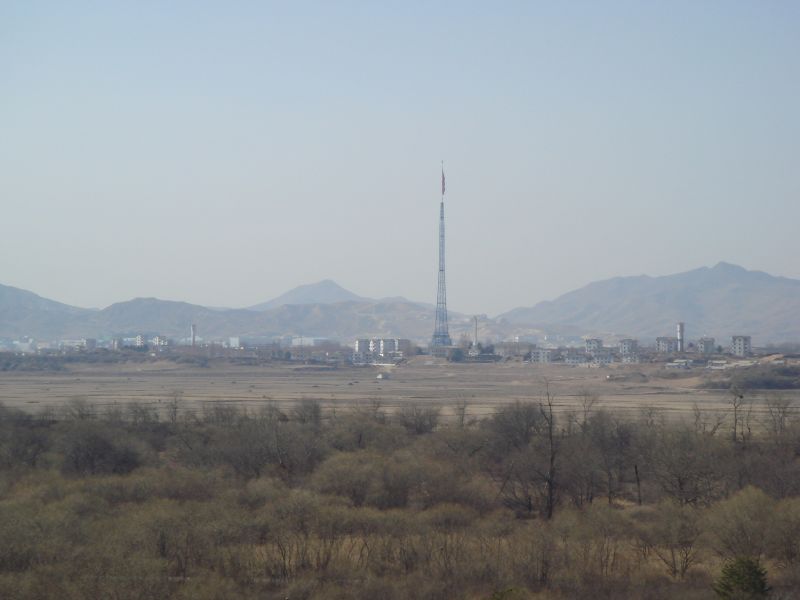 uninhabited except for a few caretakers, and is solely used as a propaganda village. The flag tower is 160m (525 feet) tall and bears one of the biggest flags in the world, weighing nearly 300kg (660 pounds). The village used to broadcast propaganda messages through massive loudspeakers for 6-12 hours a day, which could be heard in Daesong.
uninhabited except for a few caretakers, and is solely used as a propaganda village. The flag tower is 160m (525 feet) tall and bears one of the biggest flags in the world, weighing nearly 300kg (660 pounds). The village used to broadcast propaganda messages through massive loudspeakers for 6-12 hours a day, which could be heard in Daesong. We could see across the border that most of the forests had been cleared; we were told this was because of the fuel shortage in NK. And the horizon gives an indication of one of the North's problems: it has very few resources or suitable agricultural land partly because it is so mountainous, even more so than the South.
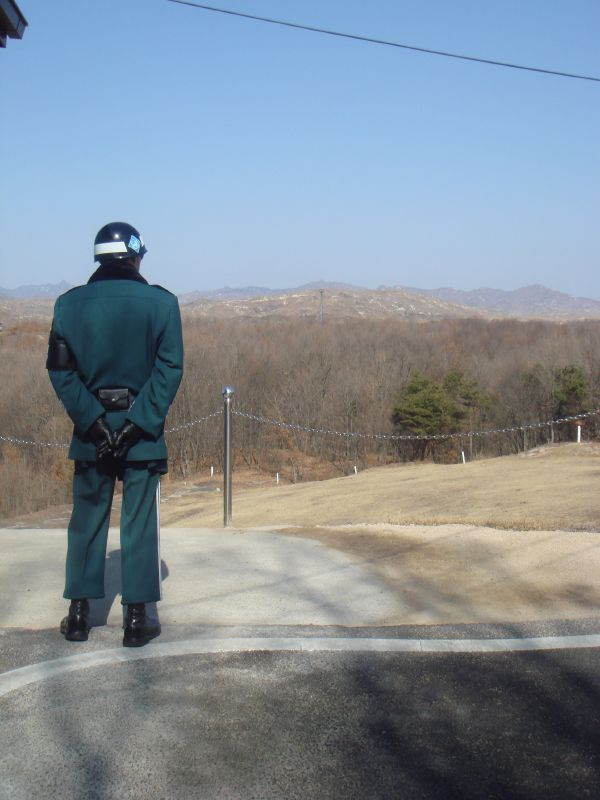
We could also see the Bridge of No Return: at the end of the Korean War, thousands of prisoners were brought here and told to decide - once and for all - which side they were going to return to. The bridge was manned until the Tree Chopping Incident of 1976 which led to the death of two American soldiers.
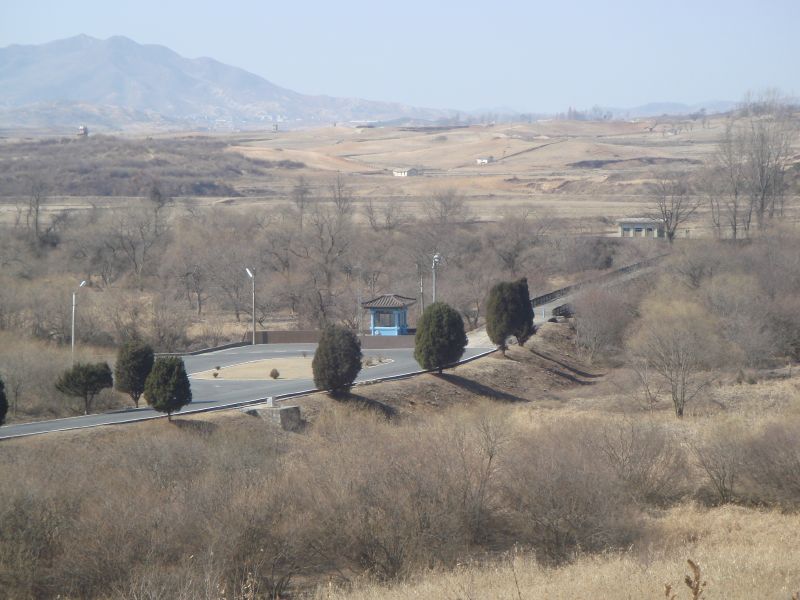
(Anyone who knows the Korean movie JSA might recognise the Bridge of No Return, as it is featured in the story. And the movie is an amusing look at what happens when soldiers from both sides end up becoming friends; it gives an interesting insight into the conflict, if you're interested.)
We left Panmunjeom, and headed back towards Camp Bonifas. We passed the site of the UNC's quick reaction force, which is able to respond to any incident withint 60-90 seconds; a soldier in full combat gear sits in readiness in a truck constantly.
Given the severity of the potential security risk and the fact that negotiations are constantly remain in a constant state of uncertainty, it was surprising to see many of the UNC soldiers waving and smiling at us as we drove past. I was always led to believe that American soldiers were deathly serious about their work. (Although, I suppose the Abu Graibh fiasco should have taught me otherwise.)
Before we left Camp Bonifas, we were taken to a souvenir shop, which simply added to the surreal atmosphere that hung over the whole trip. Available for purchase were presentation cases containing sections of barbed wire taken from the border after the end of the Korean War, and the usual t-shirts, postcards, and keyrings.
The tour then took us to an area further outside the DMZ, to see Freedom Bridge,
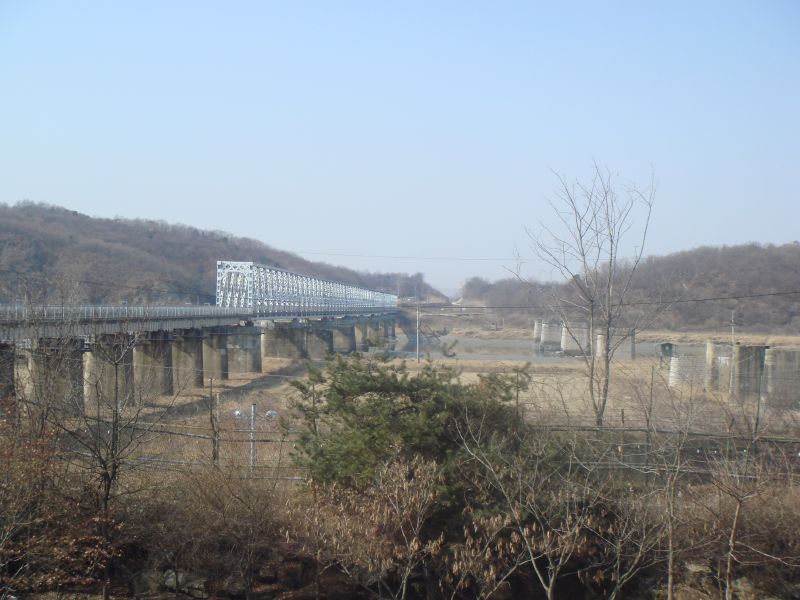 where South Korean prisoners were released at the end of the war. As they crossed the bridge, they supposedly called out "hurrah for freedom", hence the name of the bridge. Part of the bridge also now holds on of only two (unused) railway lines that cross the border. As with any other Korean tour, the day was not complete without some famous Korean food for lunch. Back on the bus, hour's drive back to Seoul, and then back home to Gumi.
where South Korean prisoners were released at the end of the war. As they crossed the bridge, they supposedly called out "hurrah for freedom", hence the name of the bridge. Part of the bridge also now holds on of only two (unused) railway lines that cross the border. As with any other Korean tour, the day was not complete without some famous Korean food for lunch. Back on the bus, hour's drive back to Seoul, and then back home to Gumi.The whole ultra-tourist vibe of the day didn't sit very well with me. But I know that it'll be worse when I do get into North Korea proper. But it was fascinating for me to see, and it has only fueled my desire to see the North even more; the idea of going back in a few months and seeing the JSA from the other side is quite exciting.
So that was the February Seoul trip. It's taken a bit more writing than I expected it to, but I wasn't going to give short shrift to something that you all know is so interesting to me.
The March update will come soon, when I'll explain why I'm wearing glasses and bunny ears:

*The Japanese and their destructive effects are a recurring feature of Korea's history. Korea's geographical position has, for thousands of year, left it vulnerable to attack from China, Russia and Japan, and the latter have definitely come out as the bad guys.
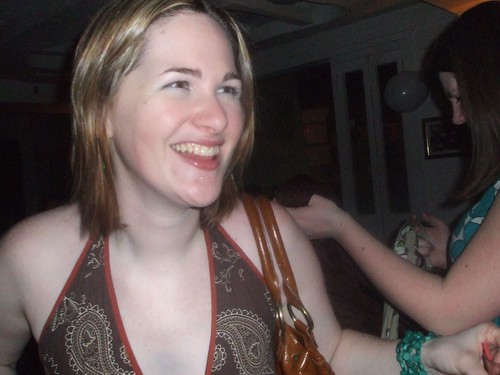

1 Comments:
No offence intended to gay people but boy, did those soldiers look gay!!!!
Step up, Mr. Soldier, YOU have missed your calling as a Village person.
Very interesting Jeni, if strangely weird.
Post a Comment
Subscribe to Post Comments [Atom]
<< Home